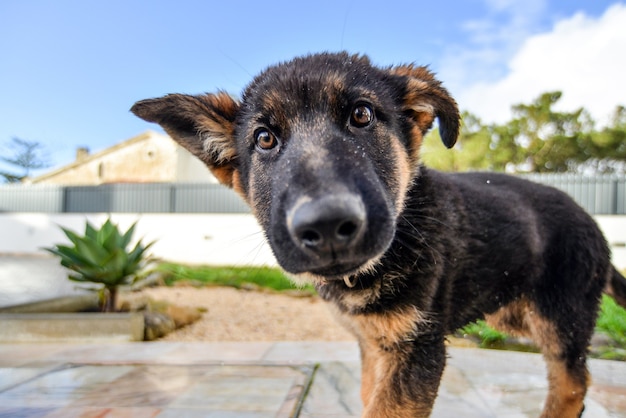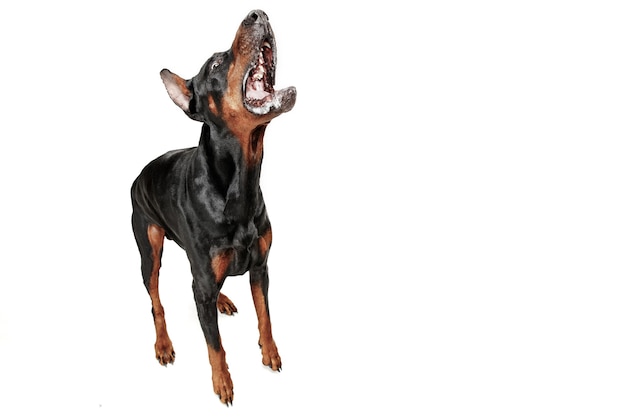Australian Cattle Dog Breed Information

Thinking about welcoming an Australian Cattle Dog into your life? These spirited and intelligent dogs are truly remarkable companions, but understanding their unique needs is paramount to a harmonious and fulfilling relationship. This comprehensive guide will delve into the key aspects of Australian Cattle Dog ownership, equipping you with the knowledge to make an informed decision.
What are the key characteristics of the Australian Cattle Dog's physical appearance, including size, coat, and coloring?

Australian Cattle Dogs, often affectionately called "Heelers" or "Blue Heelers" (referring to their common coat colour), are medium-sized dogs, typically standing 17-20 inches tall at the shoulder and weighing between 20 and 40 pounds. Their build is sturdy and muscular, reflecting their heritage as working dogs bred for herding cattle across rugged terrain. This compact, athletic physique allows for agility and endurance. Their strong legs and powerful jaws are testament to their working ancestry.
The double coat is a defining feature. A short, dense undercoat provides insulation against harsh weather, while a harsher outer coat offers protection from scrapes and the elements. This double coat requires regular grooming to prevent matting. The coat colours are striking and vary, but the most common are the "blue heeler" – a mottled blue – and the "red heeler" – a mottled red. These are not solid colours; they feature a speckled or marbled effect. White markings on the chest, legs, or face are also frequently seen.
| Characteristic | Description |
|---|---|
| Size | Medium; 17-20 inches tall at the shoulder |
| Weight | 20-40 pounds |
| Coat | Double coat; short, dense undercoat and harsh outer coat |
| Color | Blue heeler (mottled blue), red heeler (mottled red), often with white markings; variations exist |
What is the temperament and personality typically associated with Australian Cattle Dogs, and how does this affect their suitability as family pets?

Australian Cattle Dogs possess a captivating blend of traits. They are renowned for their intelligence, loyalty, and unwavering energy. Their courage and independence are deeply ingrained, stemming from their working history. This independence, while admirable, can manifest as stubbornness if not addressed properly during training. They are not easily swayed; a consistent and firm approach is essential.
As family pets, they thrive in active households that can meet their considerable physical and mental demands. They form strong bonds with their families, showing immense loyalty and affection to their loved ones. However, their inherent wariness of strangers necessitates early socialization. Exposing a puppy to various people, animals, and environments from a young age helps ensure a well-adjusted adult dog comfortable in diverse settings. They're generally not ideal for households with very young children, unless the children are supervised and the adults in the family are fully committed to proper training and management. Their herding instinct can lead to nipping at heels, a behavior easily corrected with consistent, gentle guidance.
| Trait | Description |
|---|---|
| Temperament | Intelligent, loyal, energetic, independent, courageous, can be wary of strangers |
| Suitability for Families | Best suited for active families with older, understanding children; early socialization is crucial. |
| Interaction with Strangers | Can be reserved with strangers; early and consistent socialization is essential. |
What are the common health concerns associated with Australian Cattle Dogs, and what preventative measures can owners take?

While generally hardy, Australian Cattle Dogs are susceptible to certain health issues. Hip and elbow dysplasia, conditions affecting the joints, are relatively common. Progressive retinal atrophy (PRA), a degenerative eye disease, is another concern. Some individuals may also experience deafness, either congenital or developing later in life. Certain types of cancer also pose a risk.
Proactive measures can significantly mitigate these risks. Selecting a reputable breeder who conducts health screenings on their breeding dogs is crucial. Regular veterinary check-ups, beginning in puppyhood, enable early detection of potential problems. A nutritious diet tailored to their age and activity level, coupled with regular exercise, contributes significantly to their overall health and well-being. Maintaining a healthy weight is especially important in preventing joint problems.
| Health Concern | Description |
|---|---|
| Hip and Elbow Dysplasia | Joint disorder affecting hip and elbow joints; can lead to lameness and pain. |
| Progressive Retinal Atrophy (PRA) | Progressive degeneration of the retina, leading to blindness. |
| Deafness | Hearing loss, can be congenital or develop later in life. |
| Cancer | Various types of cancer can affect Australian Cattle Dogs. |
How much exercise and mental stimulation does an Australian Cattle Dog require, and what are some suitable activities to keep them happy and healthy?

Australian Cattle Dogs are incredibly energetic and require a substantial amount of daily exercise – both physical and mental. Failing to meet their needs can lead to destructive behaviours and unhappiness. Aim for at least an hour of vigorous exercise daily, encompassing brisk walks, runs, or even a good game of fetch. Swimming is another excellent activity, providing a low-impact workout.
Mental stimulation is just as vital. These intelligent dogs thrive on having a "job" to do. Agility training, flyball, herding (if you have livestock!), or engaging in scent work are all excellent options. Interactive puzzle toys keep their minds sharp and entertained, preventing boredom. Training sessions should be incorporated into their routine, not just for obedience but also for the mental stimulation they provide. The bond formed during training is an added bonus.
| Exercise Type | Suggestions |
|---|---|
| Physical Exercise | Long walks, runs, hiking, swimming, fetch, agility courses |
| Mental Stimulation | Agility training, flyball, herding, puzzle toys, scent work, interactive games, obedience training |
What is the best way to train an Australian Cattle Dog, considering their intelligence and herding instincts?

Training an Australian Cattle Dog requires a consistent, positive approach. Positive reinforcement, using treats, praise, and rewarding desired behaviours, is far more effective than punishment. Their intelligence allows them to learn quickly, but their independence can make them seem stubborn. Patience and consistency are key. Short, frequent training sessions are generally more effective than long, intensive ones.
Their herding instinct can manifest as nipping at heels, a behaviour that needs redirection from a young age. Teach them alternative behaviours – such as "leave it" or "stay" – and reward them consistently for exhibiting those behaviours instead. Early socialization is crucial in shaping their interactions with other animals and people.
| Training Method | Description |
|---|---|
| Positive Reinforcement | Rewarding desired behaviours with treats, praise, and toys. |
| Consistency | Maintaining a consistent approach to training from all family members. |
| Early Socialization | Early exposure to various environments, people, and animals is essential. |
What is the average lifespan of an Australian Cattle Dog?

With proper care, an Australian Cattle Dog can live for 12-15 years. However, this can vary depending on genetics, lifestyle, and healthcare. Providing a balanced diet, regular exercise, and preventative veterinary care all contribute to a longer, healthier life.
| Lifespan | 12-15 years (average) |
|---|
What is the history and origin of the Australian Cattle Dog breed? How did they develop their herding abilities?

The Australian Cattle Dog's origins lie in 19th-century Australia. Bred primarily to herd cattle across vast, challenging terrains, they are a result of careful cross-breeding. Breeds contributing to their lineage include the Smithfield, Dalmatian, and possibly the Blue Merle Collie. Their remarkable herding skills were honed over generations through natural selection. Dogs best suited to the harsh conditions and effective at herding were more likely to survive and pass on their traits.
Their ability to "bite and hold" – nipping at the heels of cattle to steer them without causing significant injury – is a hallmark of the breed. This technique, combined with their intelligence, stamina, and courage, cemented their place as indispensable working dogs in the Australian outback.
| Origin | 19th-century Australia |
|---|---|
| Development | Cross-breeding of various breeds; natural selection favoured effective herding traits. |
Are Australian Cattle Dogs suitable for first-time dog owners? Why or why not?

While incredibly rewarding, Australian Cattle Dogs are not necessarily ideal for first-time dog owners. Their high energy levels, strong-willed nature, and need for consistent and experienced training can prove challenging for those without prior canine experience. Their intelligence requires a savvy trainer who can provide clear direction and consistent reinforcement.
| Suitability for First-Time Owners | Generally not recommended for inexperienced owners. |
|---|
What are the grooming needs of an Australian Cattle Dog, including brushing, bathing, and coat maintenance?
Australian Cattle Dogs are relatively low-maintenance in terms of grooming. Regular brushing, two to three times a week, helps prevent matting and keeps their coat healthy. Bathing is only necessary when they become visibly dirty, and a dog-specific shampoo should be used. While not excessive shedders, they do shed seasonally. Regular nail trimming and ear cleaning are also essential aspects of their care.
| Grooming Need | Description |
|---|---|
| Brushing | 2-3 times per week |
| Bathing | As needed |
| Nail Trimming | Regularly |
| Ear Cleaning | Regularly check for cleanliness and potential infections. |
Everyone is watching

Hypoallergenic Dog Breeds A Comp
DOGS & PUPPIESWhat does "hypoallergenic" truly mean in terms of dog breeds, and are there varying degrees of hypoa...

Newfoundland Dog Breed Informati
DOGS & PUPPIESNewfoundland Dog Breed Information: A Comprehensive GuideThinking about welcoming a Newfoundland int...

Sphynx Cat Breed Information
CATS & KITTENSSphynx Cat Breed InformationThe Sphynx cat, instantly recognizable for its lack of a traditional coa...

Savannah Cat Information
CATS & KITTENSSavannah Cat Information: A Comprehensive GuideSavannah cats, a captivating hybrid breed resulting f...

Persian Cat Characteristics and
CATS & KITTENSPersian Cat Characteristics and TemperamentPersian cats, with their captivatingly luxurious coats an...
Latest articles
-

Australian Cattle Dog Breed Information
DOGS & PUPPIESAustralian Cattle Dog Breed InformationThinking about welcoming an Australian Cattle Dog into your life? These spirited and intelligent dogs are trul...
-

Hypoallergenic Dog Breeds A Comprehensive Guide
DOGS & PUPPIESWhat does "hypoallergenic" truly mean in terms of dog breeds, and are there varying degrees of hypoallergenicity?The term "hypoallergenic" is often ba...
-

Newfoundland Dog Breed Information
DOGS & PUPPIESNewfoundland Dog Breed Information: A Comprehensive GuideThinking about welcoming a Newfoundland into your life? These magnificent dogs are known for...
-

Bernese Mountain Dog Breed Information and Care Guide
DOGS & PUPPIESThis comprehensive guide delves into the joys and responsibilities of owning a Bernese Mountain Dog, a breed renowned for its gentle nature and striki...
